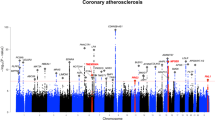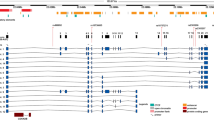Abstract
Myocardial infarction is a common disease and among the leading causes of death in the world. We previously reported association of variants in LGALS2, encoding galectin-2, with myocardial infarction susceptibility in a case-control association study in a Japanese population1. Here we identify BRAP (BRCA1-associated protein) as a galectin-2–binding protein. We report an association of SNPs in BRAP with myocardial infarction risk in a large Japanese cohort (P = 3.0 × 10−18, OR = 1.48, 2,475 cases and 2,778 controls), with replication in additional Japanese and Taiwanese cohorts (P = 4.4 × 10−6, 862 cases and 1,113 controls and P = 4.7 × 10−3, 349 cases and 994 controls, respectively). BRAP expression was observed in smooth muscle cells (SMCs) and macrophages in human atherosclerotic lesions. BRAP knockdown by siRNA using cultured coronary endothelial cells suppressed activation of NF-κB, a central mediator of inflammation.
This is a preview of subscription content, access via your institution
Access options
Subscribe to this journal
Receive 12 print issues and online access
$209.00 per year
only $17.42 per issue
Buy this article
- Purchase on Springer Link
- Instant access to full article PDF
Prices may be subject to local taxes which are calculated during checkout




Similar content being viewed by others
Accession codes
References
Ozaki, K. et al. Functional SNPs in the lymphotoxin-α gene that are associated with susceptibility to myocardial infarction. Nat. Genet. 32, 650–654 (2002).
Ozaki, K. et al. Functional variation in LGALS2 confers risk of myocardial infarction and regulates lymphotoxin-alpha secretion in vitro. Nature 429, 72–75 (2004).
PROCARDIS Consortium. A trio family study showing association of the lymphotoxin-alpha N26 (804A) allele with coronary artery disease. Eur. J. Hum. Genet. 12, 770–774 (2004).
Clarke, R. et al. Lymphotoxin-alpha gene and risk of myocardial infarction in 6,928 cases and 2,712 controls in the ISIS case-control study. PLoS. Genet. 2, e107 (2006).
Asselbergs, F.W. et al. Effects of lymphotoxin-alpha gene and galectin-2 gene polymorphisms on inflammatory biomarkers, cellular adhesion molecules and risk of coronary heart disease. Clin. Sci. 112, 291–298 (2007).
Mangino, M. et al. LGALS2 functional variant rs7291467 is not associated with susceptibility to myocardial infarction in Caucasians. Atherosclerosis 194, 112–115 (2007).
Rigaut, G. et al. A generic protein purification method for protein complex characterization and proteome exploration. Nat. Biotechnol. 17, 1030–1032 (1999).
Barrett, J.C., Fry, B., Maller, J. & Daly, M.J. Haploview: analysis and visualization of LD and haplotype maps. Bioinformatics 21, 263–265 (2005).
Tregouet, D.A. & Garelle, V. A new JAVA interface implementation of THESIAS: testing haplotype effects in association studies. Bioinformatics 23, 1038–1039 (2007).
International HapMap Consortium. A haplotype map of the human genome. Nature 437, 1299–1320 (2005).
Wellcome Trust Case Control Consortium. Genome-wide association study of 14,000 cases of seven common diseases and 3,000 shared controls. Nature 447, 661–678 (2007).
Cordell, H.J. & Clayton, D.G. A unified stepwise regression procedure for evaluating the relative effects of polymorphisms within a gene using case/control or family data: application to HLA in type 1 diabetes. Am. J. Hum. Genet. 70, 124–141 (2002).
Ozaki, K. et al. A functional SNP in PSMA6 confers risk of myocardial infarction in the Japanese population. Nat. Genet. 38, 921–925 (2006).
Heinemeyer, T. et al. Databases on transcriptional regulation: TRANSFAC, TRRD, and COMPEL. Nucleic Acids Res. 26, 362–367 (1998).
Li, S. et al. Identification of a novel cytoplasmic protein that specifically binds to nuclear localization signal motifs. J. Biol. Chem. 273, 6183–6189 (1998).
Matheny, S.A. et al. Ras regulates assembly of mitogenic signalling complexes through the effector protein IMP. Nature 427, 256–260 (2004).
Ory, S. & Morrison, D.K. Signal transduction: implications for Ras-dependent ERK signaling. Curr. Biol. 14, R277–R278 (2004).
O'Neill, L.A. Targeting signal transduction as a strategy to treat inflammatory diseases. Nat. Rev. Drug Discov. 5, 549–563 (2006).
Karin, M. & Delhase, M. The I kappa B kinase (IKK) and NF-kappa B: key elements of proinflammatory signalling. Semin. Immunol. 12, 85–98 (2000).
Breslow, J.L. Cardiovascular disease burden increases, NIH funding decreases. Nat. Med. 3, 600–601 (1997).
Mizuno, H. et al. Impact of atherosclerosis-related gene polymorphisms on mortality and recurrent events after myocardial infarction. Atherosclerosis 185, 400–405 (2006).
Andrews, N.C. & Faller, D.V. A rapid micropreparation teqhnique fore extraction of DNA-binding proteins from limiting numbers of mammalian cells. Nucleic Acids Res. 19, 2499 (1991).
Acknowledgements
We thank M. Takahashi, M. Yoshii, S. Abiko, W. Yamanobe, R. Ohishi, M. Watabe and T. Furusho for their assistance. We also thank all the other members of Center for Genomic Medicine, RIKEN and OACIS for their contribution to the completion of our study. We are also grateful to members of The Rotary Club of Osaka-Midosuji District 2660 Rotary International in Japan for supporting our study. This work was supported in part by grants from the Takeda Science Foundation, the Uehara Science Foundation, the Japanese Millennium Project and the Ministry of Education, Science, Sports, Culture and Technology of Japan and NHRI-Ex96-9607PI (Taiwan).
Author information
Authors and Affiliations
Contributions
K. Ozaki performed most of the experiments and wrote the manuscript; H.S., Y.S., H.M., T.-H.L., Y.M., S.-H.S., S.I., S.-H.H.J. and M.H. managed DNA samples and clinical information; K.I., K. Odashiro and M.N. performed the immunohistochemistry; T. Tsunoda performed the statistical analyses; A.A. and Y.O. performed the data analyses; Y.N. contributed to SNP discovery and preparation of the manuscript; and T. Tanaka supervised this study.
Corresponding author
Supplementary information
Supplementary Text and Figures
Supplementary Tables 1–7, Supplementary Figures 1 and 2 and Supplementary Note (PDF 703 kb)
Rights and permissions
About this article
Cite this article
Ozaki, K., Sato, H., Inoue, K. et al. SNPs in BRAP associated with risk of myocardial infarction in Asian populations. Nat Genet 41, 329–333 (2009). https://doi.org/10.1038/ng.326
Received:
Accepted:
Published:
Issue Date:
DOI: https://doi.org/10.1038/ng.326
This article is cited by
-
Genome-wide meta-analysis of alcohol use disorder in East Asians
Neuropsychopharmacology (2022)
-
Influence of height on endothelial maintenance activity: a narrative review
Environmental Health and Preventive Medicine (2021)
-
Potential mechanisms underlying the association between single nucleotide polymorphism (BRAP and ALDH2) and hypertension among elderly Japanese population
Scientific Reports (2020)
-
BRCA1-associated protein inhibits glioma cell proliferation and migration and glioma stem cell self-renewal via the TGF-β/PI3K/AKT/mTOR signalling pathway
Cellular Oncology (2020)
-
Short stature-related single-nucleotide polymorphism (SNP) activates endothelial repair activity in elderly Japanese
Environmental Health and Preventive Medicine (2019)



